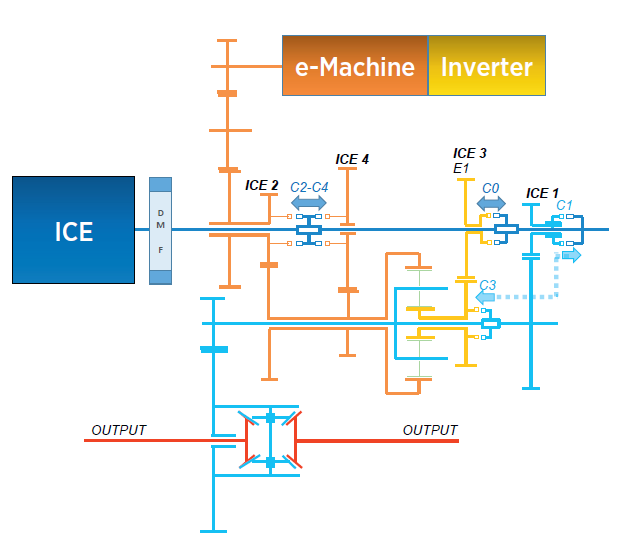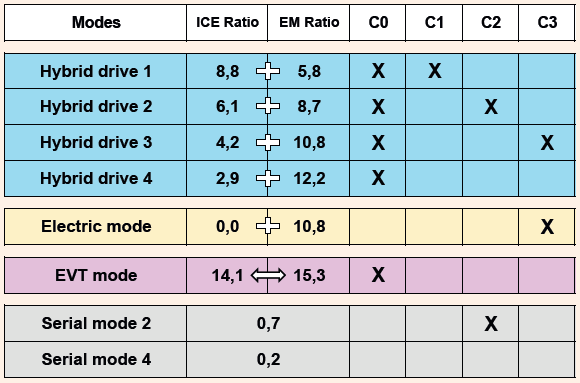
DHT Concept as Cost Reduction Opportunity
Car manufacturers around the globe have to hybridize their vehicle range to meet increasingly challenging CO2 and emission standards. We all acknowledge that CO2, emissions and energy transition will be prevalent for the years to come. This is one of the reasons why a holistic approach is required. Unavoidably, this challenge results is additional development effort and costs for all organizations involved in powertrain development.
Hybrid P0 and P1 versions are attractive solutions from a cost perspective. However, they provide limited potential to achieving future emission standards. Other approaches such as P2, P3 and P4 hybrid solutions have shown that significant vehicle alterations to integrate an electric motor and power electronics onto the front or rear drivetrain is required.
The main drivers for DHT and DHE (Dedicated Hybrid Engine) drivetrains is to facilitate cost reductions for specific sub-systems. The benefits afforded by the electric motor to reduced emissions while maintaining the same vehicle performance, can also support a de-contenting of the combustion engine and transmission. This is one logical step to compensate for the on-cost of these electrified drivetrain solutions. Cost reduction will be instrumental in facilitating DHT’s market penetration.
DHT is a radical transformation of the conventional transmission, bringing new philosophies that need a permanent electric power management. DHTs driven by an internal combustion engine and an electric machine, offer multiple running modes where the e-machine is used either as a generator or as a motor.
The Automotive industry is currently looking for efficient hybrid transmission concepts for use with a single electric machine. The aim is to find a cost effective alternative to current parallel and power-split hybrid concepts. To meet this challenge, PUNCH Powerglide is introducing a novel hybrid concept that delivers electric and mechanical states using less number of gears and dog clutches to maximize efficiency.
Philippe Ramet, Engineering Project Manager, PUNCH Powerglide
Given the high costs of batteries, amongst other items, further improvements in efficiency (reduction of losses) of the DHT is one of the key success factors.
Ambitious Goal for OEMs Needs
Having identified the technical issues, PUNCH Powerglide has developed the following requirements in order to identify a well suitable dedicated hybrid transmission concept.
A key objective is to identify technical solutions to optimize gearbox efficiency, while assuring a similar level of comfort and performance as today’s solutions. A weakness of current power-shift transmissions on the market is the use of multiple friction plates for the shifting system. It is generally recognized that dog clutches represents the most efficient solution for this type of connection. However, in today’s transmission market, only few have implemented dog clutches and expertise is still limited (ZF 9HP and Renault Locobox).
In order to limit vehicle electrification cost, a de-contenting approach has been considered for the DHT definition. A solution with four mechanical gear states (ICE) and one electric gear state is sufficient to meet the emission targets. Apart from the significant reduction of components, a considerable benefit is realized in the reduction of installation space.
The project target is to use one single high-speed IM (induction machine) where torque, speed and packaging is adapted to suit various hybrid vehicles. The number of gears and ratios are to be flexible to cater for various vehicle requirements such as gradeability and top speed.
Even if the concept must utilize dog clutch, the DHT has to be a powershift transmission and has to fulfill standard hybrid functions such as regeneration / recuperation, boost mode, and serial mode.


PUNCH Powerglide’s Concept: a DHT with Dog Clutches
PUNCH Powerglide’s research outcome has resulted in a DHT with modular powerflow.
The core element of the powerflow is a single planetary gear set where the carrier is directly connected to the output shaft, the ring gear to the electrical machine, and the sun to the combustion engine through a C0 connection. This is the key element to enable an EVT mode in which the relative speed of the connection elements is controlled.
This powerflow provides 8 different modes comprising: 1 electric gear, 4 mechanical gears (ICE), 1 EVT mode, and 2 serial modes. Only 5 connection elements are needed to provide these states. In hybrid mode, the torque at the wheel is a combination of the combustion engine and electrical machine torques. In this mode, the electric machine is used either as a generator or as a motor, allowing for boost, regeneration (also at standstill) and recuperation functions.
The primary and intermediate shafts contain all the connection elements and gears. The advantage of this configuration is to limit the number of transmission components, i.e. main shafts, bearings and casings. This arrangement is significant in minimizing the transmission length and helps facilitating the transmission integration into what is typically a limited workspace in hybrid variants. Naturally, lowering the component count also results in cost reduction.

Activation of various connection elements enable the various mode and gear states. These are described in the table depicted in figure 3. The ratios shown in this table are only one example and are modifiable through different gear designs, i.e. number of teeth.
In hybrid mode, upshifts and downshifts are performed with the release of one connection element (dog clutch) and the application of another one. However, during this state change, C0 remains engaged putting the transmission into EVT mode. This mode is used to control the speed of the connection elements for shifting into the various states.
Author:
Philippe Ramet, Engineering Project Manager, PUNCH Powerglide
